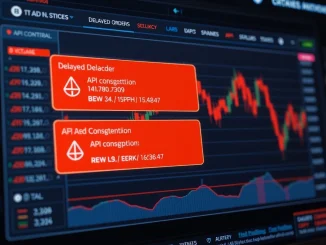
The cryptocurrency market is a constantly evolving beast, and recent on-chain analysis is pointing towards a fascinating power shift. While the supply of stablecoins, those crypto assets pegged to fiat currencies like the US dollar, has seen significant growth since November 2024, their direct impact on the spot market seems to be waning. Are we witnessing a fundamental change in how market liquidity is generated and how price action unfolds? Let’s dive into the details and understand what this means for you as a crypto enthusiast or investor.
The Explosive Growth of Stablecoin Supply: A Deeper Look
Since November 2024, the stablecoin supply has indeed experienced a notable surge. This growth, often seen as a positive indicator of capital entering the crypto space, initially suggests increased buying power and potential for market rallies. However, the on-chain data from analyst theKriptolik at CryptoQuant paints a more nuanced picture. It’s not just about the quantity of stablecoins, but where they are being held and how they are being utilized.
Here’s a breakdown of what’s been observed:
- Surging Stablecoin Supply: As reported, the overall supply of stablecoins has increased, indicating more capital is available within the crypto ecosystem.
- Declining Spot Exchange Reserves: Interestingly, despite the increased supply, the reserves of stablecoins held on spot exchanges are actually decreasing. This suggests that while more stablecoins exist, they are not readily available for immediate spot market transactions.
- Soaring Derivatives Exchange Holdings: In stark contrast to spot exchanges, derivatives exchanges are witnessing a sharp rise in stablecoin holdings. This is a critical indicator that stablecoins are increasingly being deployed in the derivatives market rather than for direct spot purchases.

Derivatives Market Takes Center Stage: What Does It Mean for Crypto Liquidity?
The shift of stablecoins towards derivatives markets has profound implications for crypto liquidity and price discovery. Derivatives, such as futures and options contracts, allow traders to speculate on the price movements of cryptocurrencies without actually holding the underlying assets. This market is inherently leveraged, meaning traders can control larger positions with less capital.
Here’s why this shift is significant:
- Liquidity in Derivatives, Not Spot: The increased stablecoin holdings in derivatives exchanges suggest that liquidity is now concentrated in these markets. This means that price action is more likely to be influenced by derivatives trading activity than by spot market demand.
- Impact on Price Discovery: Traditionally, spot markets were considered the primary venue for price discovery in cryptocurrencies. However, with derivatives markets gaining prominence, price discovery might be increasingly influenced by futures and options trading, potentially leading to different market dynamics.
- Increased Leverage and Volatility: Derivatives markets inherently involve leverage. Higher stablecoin inflows into these markets could amplify leverage, potentially leading to increased market volatility. This is because larger positions can be controlled with the same amount of capital, magnifying both gains and losses.
Spot Trading Demand Shortage: Are We Facing a Liquidity Crisis or a Demand Problem?
The analyst’s note highlights a crucial distinction: the market is facing a spot trading demand shortage rather than a traditional liquidity crisis. While there are ample stablecoins in the system, they are not being directed towards spot exchanges to fuel buying pressure. This is a subtle but important difference.
Let’s clarify the difference:
| Concept | Description | Implication |
|---|---|---|
| Liquidity Crisis | A situation where there is a general lack of funds available in the market. Buyers and sellers struggle to find counterparties, leading to frozen markets and sharp price declines. | Broad market dysfunction, difficulty in executing trades at fair prices. |
| Spot Trading Demand Shortage | Sufficient funds (stablecoins) exist within the ecosystem, but they are not being actively used for buying cryptocurrencies on spot exchanges. Demand for immediate purchase is low relative to supply. | Price stagnation or downward pressure in spot markets, even with ample stablecoin supply. |
In essence, we are not necessarily lacking funds in the crypto world, but rather the willingness or incentive to use those funds for immediate spot trading of cryptocurrencies. This could be due to various factors, such as market sentiment, risk aversion, or a preference for leveraged trading in derivatives markets.
Navigating Market Volatility: Strategies in a Derivatives-Driven Landscape
The analysis suggests that until stablecoin volume flows back into spot markets, we can expect short-term market volatility to persist. This is a crucial insight for traders and investors. How can you navigate this derivatives-driven market?
Here are some actionable insights:
- Monitor Derivatives Market Activity: Pay close attention to the open interest and trading volume on major derivatives exchanges. These metrics can provide clues about market sentiment and potential price swings.
- Understand Leverage Risks: Be acutely aware of the risks associated with leveraged trading in derivatives. Volatility can be amplified, leading to both significant gains and losses. Manage your risk accordingly and avoid over-leveraging.
- Look for Spot Market Re-engagement Signals: Keep an eye out for any signs that stablecoin volume is returning to spot exchanges. This could be indicated by increasing spot exchange reserves and a narrowing gap between spot and derivatives market prices. Such a shift could signal a change in market dynamics and potentially reduced volatility.
- Diversify Trading Strategies: Consider diversifying your trading strategies to incorporate both spot and derivatives markets, but with a clear understanding of the unique risks and opportunities each presents in the current environment.
The Future of Stablecoin Influence: Will Spot Markets Reclaim Dominance?
The question remains: will stablecoin volume eventually shift back into spot markets, or is this a more permanent change in market structure? The answer is likely complex and depends on various factors, including overall market sentiment, regulatory developments, and the evolution of both spot and derivatives markets.
Possible scenarios include:
- Cyclical Shift: The current dominance of derivatives might be a cyclical phase. Improved market sentiment or new catalysts could drive renewed interest in spot trading, leading to a rebalancing of stablecoin flows.
- Structural Change: It’s also possible that the increased sophistication and accessibility of derivatives markets are leading to a more structural shift, with derivatives becoming the primary venue for price discovery and liquidity provision in the long term.
- Hybrid Model: A hybrid model could emerge, where both spot and derivatives markets play significant but distinct roles. Spot markets might be used more for long-term holding and fundamental value accumulation, while derivatives markets become the primary arena for active trading and speculation.
Conclusion: Adapting to the Evolving Crypto Landscape
The crypto market is in constant flux. The current trend of stablecoin supply growth coupled with a shift in market influence towards derivatives is a significant development. It signals a market that is becoming increasingly driven by leveraged trading and derivatives activity, at least for now. Understanding this shift is crucial for navigating the market effectively and managing risk. By monitoring market dynamics, adapting trading strategies, and staying informed about evolving trends, you can position yourself to thrive in this exciting and ever-changing landscape. Keep your eyes peeled for signals of change, and remember, in crypto, adaptability is key to success.



